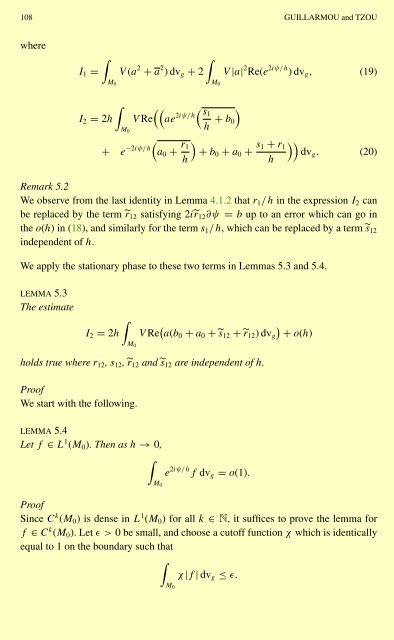NEAR OPTIMAL BOUNDS IN FREIMAN'S THEOREM
NEAR OPTIMAL BOUNDS IN FREIMAN'S THEOREM
NEAR OPTIMAL BOUNDS IN FREIMAN'S THEOREM
Create successful ePaper yourself
Turn your PDF publications into a flip-book with our unique Google optimized e-Paper software.
108 GUILLARMOU and TZOU<br />
where<br />
I1 =<br />
<br />
M0<br />
<br />
I2 = 2h<br />
V (a 2 + a 2 <br />
)dvg + 2<br />
M0<br />
<br />
V Re ae 2iψ/h<br />
<br />
s1<br />
h<br />
+ e −2iψ/h<br />
<br />
a0 + r1<br />
<br />
h<br />
M0<br />
V |a| 2 Re(e 2iψ/h )dvg, (19)<br />
+ b0<br />
<br />
+ b0 + a0 + s1 + r1<br />
h<br />
<br />
dvg. (20)<br />
Remark 5.2<br />
We observe from the last identity in Lemma 4.1.2 that r1/h in the expression I2 can<br />
be replaced by the term r12 satisfying 2ir12∂ψ = b up to an error which can go in<br />
the o(h) in (18), and similarly for the term s1/h, which can be replaced by a terms12<br />
independent of h.<br />
We apply the stationary phase to these two terms in Lemmas 5.3 and 5.4.<br />
LEMMA 5.3<br />
The estimate<br />
<br />
I2 = 2h<br />
M0<br />
V Re <br />
a(b0 + a0 +s12 +r12)dvg + o(h)<br />
holds true where r12, s12,r12 ands12 are independent of h.<br />
Proof<br />
We start with the following.<br />
LEMMA 5.4<br />
Let f ∈ L 1 (M0). Thenash → 0,<br />
<br />
M0<br />
e 2iψ/h f dvg = o(1).<br />
Proof<br />
Since C k (M0) is dense in L 1 (M0) for all k ∈ N, it suffices to prove the lemma for<br />
f ∈ C k (M0).Letɛ>0 be small, and choose a cutoff function χ which is identically<br />
equal to 1 on the boundary such that<br />
<br />
M0<br />
χ|f | dvg ≤ ɛ.

















